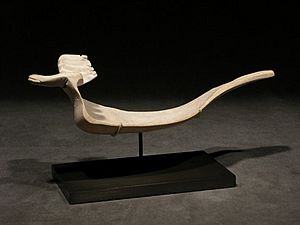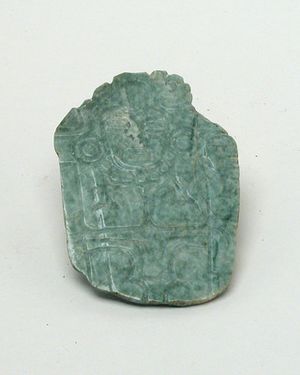Economy of the Maya civilization facts for kids
The economy is how people in a place make, share, and use goods and services. Think of it as a big system where people work together to get what they need and want. The ancient Maya had a unique economy. They didn't use money like we do today. Instead, they traded things like cacao beans and copper bells, or exchanged services. Even though we don't have much evidence for trading everyday items, we know they traded important artifacts and luxury goods.
Even though most Maya people were farmers, they had a strong system for trading between different towns. This system allowed some people to become specialists, like potters or toolmakers, and supported merchants who traveled along trade routes. Maya rulers became powerful not just by controlling resources, but also by managing how special goods and important items like salt were made and shared. Maya workers also paid a "labor tax" by helping build palaces, temples, and public buildings. A successful ruler in war could control more workers and demand goods from defeated enemies, making their economy even stronger.
The Maya civilization spread across the Yucatán Peninsula and parts of modern Mexico, Guatemala, Honduras, El Salvador, and Belize. Large Maya cities would trade their most common resources with groups who didn't have them. This local trade helped communities use what they had a lot of, exchanging it for things they couldn't find nearby. This created a complex economy where different communities relied on each other, helping everyone get what they needed and making the whole Maya kingdom stronger.
Contents
How the Maya Economy Worked
Evidence shows that the Maya had advanced marketplaces, suggesting a complex economic system. Archaeologists studied the soil at Chunchucmil, an ancient Maya city, and compared it to a modern market. They found similar chemical signs, meaning Chunchucmil likely had a busy marketplace long ago. This suggests the Maya used markets, not just a tax system, to share goods. It also points to an important group of merchants, like a "middle class."
Many ancient Maya sites show proof of marketplaces and trade networks. For example, archaeologists have found rare shells and jadeite far from where they naturally occur. This proves that goods traveled long distances. However, the trade of luxury items also shows a clear social structure. Experts still debate how Maya rulers controlled the economy and trade.
Maya Rulers and Trade
Many believe that Maya rulers controlled the making and sharing of valuable goods. This helped them stay in power and show their high status. By controlling these special items, rulers could also spread their ideas and beliefs, making them even more powerful.

However, some archaeologists think there was more flexibility. They suggest that rulers and skilled craftspeople might have had many roles. This means that even rulers might have been involved in making things, and artisans might have had a higher social standing than previously thought.
Rulers likely controlled the distribution of luxury items. Here are some ideas on how they might have done this:
- Specialized Production: Rulers might have ordered artisans to make specific items. They could have had workshops in their palaces or homes. This gave them strong control over the artisans and the final products.
- Collecting Goods: Rulers might have collected finished items from regular households. This would have involved trade agreements or a system of exchange, possibly through marketplaces.
- Controlling Distribution: Even if regular households made goods, rulers might have controlled how these goods were distributed. This helped them gather resources and maintain power over their people.
Sadly, much of the evidence for large-scale control of luxury goods comes from burial sites. This is because luxury items were often rare and made from "exotic" materials, making them valuable. The lack of these items outside of elite burials suggests a "palace economy." This means valuable goods were mostly exchanged between rulers and their skilled artisans to strengthen alliances. However, some argue that regular people also made these goods, suggesting a more open market economy.
It's clear that the best and rarest goods usually went to the elite. But these items were more widely available in areas where the raw materials were found naturally. For example, jadeite was valuable everywhere in the Maya kingdom. It was used for tools and religious items, and was important in funerals and rituals.
Chunchucmil: A Market City
Chunchucmil is an ancient Maya city in Mexico. Unlike many Maya cities with grand central buildings, Chunchucmil stands out. It was a very large and crowded city, but it was built in an area not great for farming. This suggests that Chunchucmil relied heavily on trade and had a commercial economy, rather than just a "palace economy."
This marketplace was a hub for imported goods. It also served merchants traveling along important sea trade routes. Roads connected the market to surrounding areas, making it easy for merchants to access.
Scientists studied the soil at Chunchucmil and found high levels of phosphates. These high levels were similar to those found in modern markets. This suggests that a lot of food and other organic materials were traded or discarded there for a long time. This central gathering place strongly suggests it was a marketplace.
How Labor Was Organized
The Maya economy often involved a system where people worked for their rulers without direct payment. This was like a labor tax. It's unclear exactly how this system worked or if people received any compensation. Some experts believe that changes in Maya culture over time might show shifts in how labor was used.
Trade and Specialization
Trade was key to the economic growth of Maya cities. It was like a free market system, except in major cities where the government had more control. These large cities often had established markets that connected with other major civilizations like the Olmec and Teotihuacán. The value of items changed depending on how far they traveled from their origin.
The Maya traded two main types of goods:
- Prestige Items: These were luxury items like jade, gold, copper, fancy pottery, and items used in rituals. They were symbols of high status for the upper class.
- Subsistence Items: These were everyday necessities like clothing, food, tools, salt, and stone materials.
Merchants became very important during the Classic Periods. They helped the middle class and elite grow. Merchants made it profitable for people to specialize in skills like pottery or making stone tools.
Ceramic Trade

Research shows that the ancient Maya economy was very complex. It had different levels of trade networks. Archaeologists study the materials used in Maya pottery to understand trade. Each community often had a unique "recipe" for their clay.
In the Belize River Valley, archaeologists found two different trade patterns for local pottery. Some pottery was found everywhere, suggesting widespread trade. Other types were found only in certain places, meaning more exclusive trade. This shows that different communities participated in trade differently, depending on their size and resources.
They also found pottery made with volcanic ash, which was not local. This means these communities traded with distant regions. The ash was likely imported as finished pottery, not as raw material. These findings suggest that the Maya had a very complex economy with local, regional, and long-distance trade.
Important Trade Materials
The Maya had many natural resources that acted like currency. Cacao beans, marine shells, maize, chili peppers, manioc, amaranth, palms, vanilla, avocado, and tobacco were all traded. Their value changed based on how rare they were. Farming began around 3000 B.C. with maize and beans. The Maya also used obsidian, jade, and other rocks for tools, as they didn't use metal until much later.
Some of the most important items traded over long distances were salt, obsidian, jade, turquoise, and quetzal feathers. Large market centers in major cities were places where merchants could get goods to sell in smaller towns. Everyday items were mostly traded in these big city markets. However, items for the elite, like rare feathers and jadeite, were specially ordered by the upper class.
Jadeite
The only natural sources of jade in Mesoamerica were in the Maya area, specifically in Guatemala. Because it was found there, jade was very important in the Maya economy and had religious meaning. It was linked to farming and morality. Jade was often carved to represent the center of the world, the maize god, or ancestors. It was also placed in burial chambers.
While there's evidence of rulers managing jade production, recent discoveries show that regular households also made jade items. This suggests that the production of luxury goods was more complex than previously thought. Jadeite from this region was traded throughout the Maya world and beyond. For example, pottery from other regions found at Maya sites shows how far trade reached.
Some experts believe that jadeite was so common in its natural source area that it was hard for rulers to control its production completely. However, skilled artisans could create very intricate jade pieces. These unique items were likely controlled by the elite. Simple jade beads, which were less valuable, have been found in both elite and non-elite homes. Some think these beads might have been an early form of currency.
Obsidian
Obsidian, a sharp volcanic glass, was widely used by the Maya. It was found at many sites, not just in elite homes. This suggests that obsidian was not just a luxury item given out by rulers. Instead, it likely circulated through direct exchanges or marketplace transactions. Even if rulers controlled its import, most obsidian blades were used for everyday tasks and found in regular household trash.


